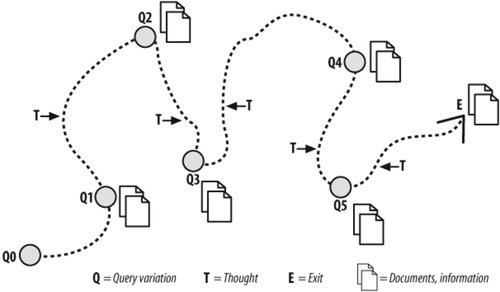Section 3.3. Information-Seeking Behaviors
3.3. Information-Seeking BehaviorsHow do web site users find information? They enter queries in search systems, browse from link to link, and ask humans for help (through email, chat interfaces, and so forth). Searching, browsing, and asking are all methods for finding, and are the basic building blocks of information-seeking behavior. There are two other major aspects to seeking behaviors: integration and iteration. We often integrate searching, browsing, and asking in the same finding session. Figure 3-3 shows how you might search your corporate intranet for guidelines on traveling abroad. You might first browse your way through the intranet portal to the HR site, browse the policies area, and then search for the policy that includes the string "international travel." If you still didn't get your question answered, you might send an email to Biff, the person responsible for that policy, to ask exactly what your per diem will be while spending the week in Timbuktu. Let's hope your intranet's information architecture was designed to support such integration! Figure 3-3. Integrated browsing, searching, and asking over many iterations Figure 3-3 also illustrates the iteration you may go through during one finding session. After all, we don't always get things right the first time. And our information needs may change along the way, causing us to try new approaches with each new iteration. So, while you may have begun with a broad quest for "guidelines on traveling abroad," you might be satisfied to find something as specific as "recommended per diem in Timbuktu" by the time you're done. Each iteration of searching, browsing, asking, and interacting with content can greatly impact what it is we're seeking. These different components of information-seeking behaviors come together in complex models, such as the "berry-picking" model[*] developed by Dr. Marcia Bates of the University of Southern California. In this model (shown in Figure 3-4), users start with an information need, formulate an information request (a query), and then move iteratively through an information system along potentially complex paths, picking bits of information ("berries") along the way. In the process, they modify their information requests as they learn more about what they need and what information is available from the system.
Figure 3-4. The "berry-picking" model of how users move through an information system The berry-picking diagram looks messy, much more so than the "too-simple" model. It should; that's the way our minds often work. After all, we're not automatons. If the berry-picking model is common to your site's users, you'll want to look for ways to support moving easily from search to browse and back again. Yahoo! provides one such integrated approach to consider: you can search within the subcategories you find through browsing, as shown in Figure 3-5. And you can browse through categories that you find by searching, as shown in Figure 3-6. Figure 3-5. First search, then browse: searching Yahoo! for "baseball" retrieves categories that can be browsed Figure 3-6. First browse, then search: Yahoo!'s categories are themselves searchable Another useful model is the "pearl-growing" approach. Users start with one or a few good documents that are exactly what they need. They want to get "more like this one." To meet this need, Google and many other search engines allow users to do just that: Google provides a command called "Similar pages" next to each search result. A similar approach is to allow users to link from a "good" document to documents indexed with the same keywords. In sites that contain scientific papers and other documents that are heavy with citations, you can find other papers that share many of the same citations as yours or that have been co-cited with the one you like. Del.icio.us and Flickr are recent examples of sites that allow users to navigate to items that share something in common; in this case, the same user-supplied tag. All of these architectural approaches help us find "more like this one." Corporate portals and intranets often utilize a "two-step" model. Confronted with a site consisting of links to perhaps hundreds of departmental subsites, users first need to know where to look for the information they need. They might search or browse through a directory until they find a good candidate or two, and then perform the second step: looking for information within those subsites. Their seeking behaviors may be radically different for each of these two steps; certainly, the information architectures typical of portals are usually nothing like those of departmental subsites. |
EAN: 2147483647
Pages: 194